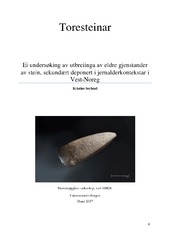Toresteinar - Ei undersøking av utbreiinga av eldre gjenstander av stein, sekundært deponert i jernalderkontekstar i Vest-Noreg
Master thesis
Permanent lenke
https://hdl.handle.net/1956/17518Utgivelsesdato
2017Metadata
Vis full innførselSammendrag
Denne oppgåva tek føre seg gjenstander i stein primært tilverka i steinalder og bronsealder, som har blitt sekundært deponertt i yngre kontekstar frå jernader. Desse gjenstandane har ofte blitt kalt torestein, tordenkil, åsksten, thunderstone, thunderbolt og liknande namn kopla til folkloriske førestellingar om torevêr. Eg har undersøkt utbreiinga av denne gjenstandgruppa i Vest-Noreg i kontekstar frå tidsrommet ca. Kr.f.-1030 e.Kr.. Forhåpentlegvis har denne undersøkinga bidrat til å auke kunnskap om denne gjenstandgruppa In this thesis I have focused on the phenomenon of the deposition and use of the so called “thunderstones” or “thunderbolts” in Skandinavian Iron Age. The term thunderstone or thunderbolts mostly represent artifacts of stone originally produced in the stone age or in the bronze age, and secondarily used and/or deposited in the Iron Age, Medieval period or in more modern folkloric context. Some of the Scandinavian terms for thunderstone is torestein, tordenkil, åskvigg and torevigg. The question I have tried to answer in this study is: How big is the distribution of artifacts of stone originally made in the stone age or the bronze age, which are consciously secondarily deposited in the time between year zero and 1030 years AD in Iron Age context like house structures and graves in the western part of Norway? The purpose of this thesis is to shed some light on this phenomenon of thunderstones in pre-Christian Scandinavia, and hopefully increase knowledge, and interest for this topic.
